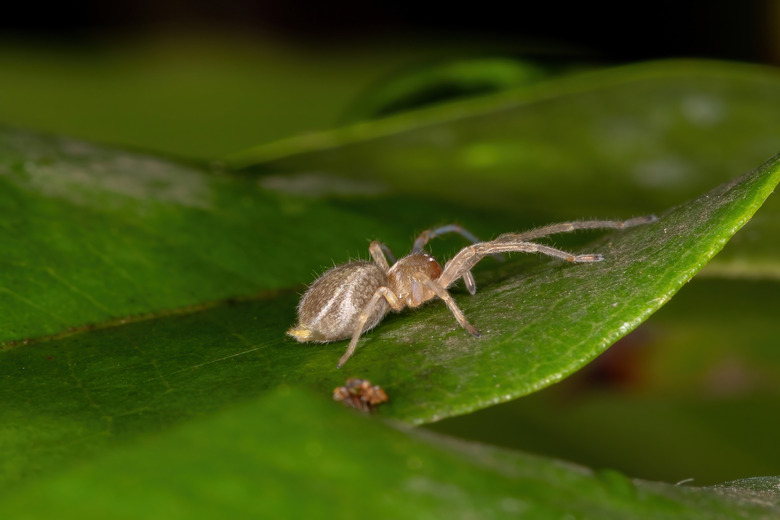White Spiders In Florida
There are several white spiders in Florida. Ghost spiders (Anyphaenidae family) are nearly all white. Others, like the Florida crab spider (Gasteracantha cancriformis), humpbacked orb weaver (Eustala anastera) and tropical orb weaver (Eriophora ravilla) have distinct white markings.
Crab Spider in Florida
Crab Spider in Florida
The crab spider in Florida, also known as the spinybacked orb weaver spider, has a black thorax and legs with a distinct oval white abdomen which is covered in black dots and red spines. The females of this species of tiny white spider grow between 0.2 and 0.35 inches long. Unusually, its abdomen is broader than it is long, measuring between 0.43 and 0.51 inches. The males are smaller, growing between 0.08 and 0.12 inches long with white and gray spots.
The female crab spiders build webs and patiently wait for insects to fly in and get stuck in the center. When the insect is stuck, she runs out, paralyzes it by biting it, drags it off to the side and eats it. If the insect she catches is particularly large, she may wrap it in silk before carrying it to the edge of the web. Florida crab spider bites are not reported to be dangerous to humans.
In Florida, females are most commonly sighted between October and January, though they can be seen all year. Males are most commonly spotted in October and November, and are rarely seen in December and January. These times coincide with breeding season. To mate, females wait in their nests for males to come to find them. After mating, she lays her eggs bundled up in silk for protection underneath a leaf and then she dies.
Humpbacked Orb Weaver in Florida
Humpbacked Orb Weaver in Florida
The humpbacked orb weaver spider has a mottled cream and light brown body and legs. They often have a distinct dark brown strip running vertically down the abdomen. Orb weaver spiders build large webs at night stretching between branches of trees, in doorways, across windows or between posts.
These white spiders are venomous. They use their venom to subdue the prey that lands in their web. However, their bite usually isn't poisonous to humans. Initially if bitten it might feel like a bee sting and leave a mark, but unless someone is allergic to spider venom there are no serious side-effects.
Tropical Orb Weaver in Florida
Tropical Orb Weaver in Florida
Tropical orb weaver spiders come in a wide variety of colors and patterns. Female coloration ranges from nearly all white to nearly all black. Commonly in Florida the females have a reddish-brown body and legs and often have white spots or a vertical white stripe on their abdomen. Males are similar to females but typically have more gray. One thing they have in common regardless of their patterns and body color are the small white hairs, called setae, that cover their entire body and legs.
Females grow to be anywhere from 0.47 inches to 0.94 inches long. The males are smaller. Like the other spiders in the orb weaver family their bites are typically not dangerous to humans. Swelling and soreness may arise at the bite spot but this should subside in a few hours.
Ghost Spiders in Florida
Ghost Spiders in Florida
Three species of ghost spiders are common in Florida. The yellow ghost spider (Hibana velox) has a pale yellow body with light brown markings. The garden ghost spider (H. gracilis) has a pale cream, light brown or yellowish coloration. Lastly, the green ghost spider (Wulfila albens) almost looks like a white clear spider. It has white legs with a pale green head and pale brown abdomen, which can appear somewhat translucent.
At night ghost spiders come out from their hidden silky homes to hunt small insects. The adults are most commonly found outdoors in the spring and summer months, but can be found all year long in the warm climate of Florida. In places with cooler climates they spend the winter months in their subadult stages.
Ghost spiders are typically not dangerous to humans. If bitten it will feel like a small pin prick or bee sting. Localized swelling, soreness or a small wound may appear short-term then heal.
Cite This Article
MLA
Jerrett, Adrianne. "White Spiders In Florida" sciencing.com, https://www.sciencing.com/white-spiders-in-florida-12517833/. 30 September 2021.
APA
Jerrett, Adrianne. (2021, September 30). White Spiders In Florida. sciencing.com. Retrieved from https://www.sciencing.com/white-spiders-in-florida-12517833/
Chicago
Jerrett, Adrianne. White Spiders In Florida last modified March 24, 2022. https://www.sciencing.com/white-spiders-in-florida-12517833/
